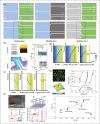Heterostructured Electrocatalysts: from Fundamental Microkinetic Model to Electron Configuration and Interfacial Reactive Microenvironment
- PMID: 40040288
- PMCID: PMC12004922
- DOI: 10.1002/adma.202418146
Heterostructured Electrocatalysts: from Fundamental Microkinetic Model to Electron Configuration and Interfacial Reactive Microenvironment
Abstract
Electrocatalysts can efficiently convert earth-abundant simple molecules into high-value-added products. In this context, heterostructures, which are largely determined by the interface, have emerged as a pivotal architecture for enhancing the activity of electrocatalysts. In this review, the atomistic understanding of heterostructured electrocatalysts is considered, focusing on the reaction kinetic rate and electron configuration, gained from both empirical studies and theoretical models. We start from the fundamentals of the microkinetic model, adsorption energy theory, and electric double layer model. The importance of heterostructures to accelerate electrochemical processes via modulating electron configuration and interfacial reactive microenvironment is highlighted, by considering rectification, space charge region, built-in electric field, synergistic interactions, lattice strain, and geometric effect. We conclude this review by summarizing the challenges and perspectives in the field of heterostructured electrocatalysts, such as the determination of transition state energy, their dynamic evolution, refinement of the theoretical approaches, and the use of machine learning.
Keywords: adsorption energy theory; electronic state; heterostructured electrocatalyst; interfacial reactive microenvironment; microkinetic model.
© 2025 The Author(s). Advanced Materials published by Wiley‐VCH GmbH.
Conflict of interest statement
The authors declare no conflict of interest.
Figures





References
-
- a) Robinson A., Lehmann J., Barriopedro D., Rahmstorf S., Coumou D., npj Clim. Atmosph. Sci. 2021, 4, 45;
- b) Yao H., Zhao L., He Y., Dong W., Shen X., Wang J., Hu Y., Ling J., Xiao Z., Huang C., Commun. Earth Environ. 2024, 5, 464.
-
- Seh Z. W., Kibsgaard J., Dickens C. F., Chorkendorff I., Norskov J. K., Jaramillo T. F., Science 2017, 355, eaad4998. - PubMed
-
- a) Prabhu P., Do V.‐H., Peng C. K., Hu H., Chen S.‐Y., Choi J.‐H., Lin Y.‐G., Lee J.‐M., ACS Nano 2023, 17, 10733; - PubMed
- b) Jose V., Do V. H., Prabhu P., Peng C. K., Chen S. Y., Zhou Y., Lin Y. G., Lee J. M., Adv. Energy Mater. 2023, 13, 2301119.
-
- Do V. H., Prabhu P., Jose V., Yoshida T., Zhou Y., Miwa H., Kaneko T., Uruga T., Iwasawa Y., Lee J. M., Adv. Mater. 2023, 35, 2208860. - PubMed
-
- Wu T., Han M. Y., Xu Z. J., ACS Nano 2022, 16, 8531. - PubMed
Publication types
Grants and funding
LinkOut - more resources
Full Text Sources

